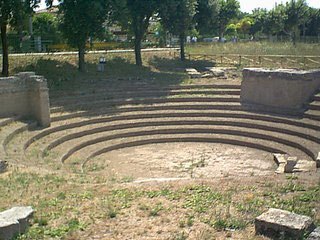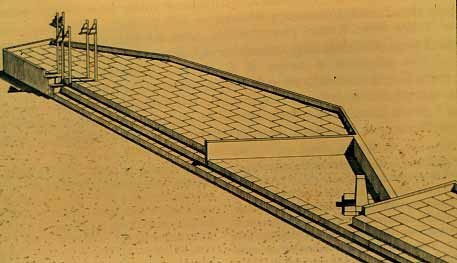Roman Building Projects
A Marker of Social Organization and Military Success
Republic
Comitium
- Although the Comitium was built late in the archaic (Regal) period, it was during the Republican period that it gained in importance. Consequently, the building program reflected its c1hanging fortunes.
- Between 300 and 250 BC (around the time of the First Punic War), the Comitium was restructured
- Modeled on Greek Ekklesiasteria
- Circular
- Stairs lead all the way down to the lowest central space
- Representatives were seated while a speaker spoke from the tribunal or Rostra
Tribunal/Speaker’s Podium/Rostra (later Rostra Vetera)
- The speaker’s platform next to the Comitium
- Transformed into a monument celebrating the Roman naval victory over Antium (338 BC) by mounting 6 bronze ramming beaks (Rostra) on its side
- In the later Imperial (Principate) period it was called Elder Rostra (Rostra Vetera)
Columna Maenia 338 BC
- This was an honorary column celebrating Gaius Maenius for his victory over the Latins at the battle of Antium in 338 BC. It celebrates the same event as the Rostra
Graecostasis
- The Graecostasis was a raised platform, perhaps made of wood, off to the side of the Comitium, but a functional part of it
- Foreign diplomats and representatives were not allowed inside the Comitium or the Curia during deliberations, so they would stand on the Graecostasis and listen or speak to the assembly or Senate
- They could also see and hear speakers orating on the Rostra. This structure was a place of honor
Columns and Statues around and in the Comitium
- The Comitium was populated by many dedicatory statues and columns
- Rostrated Column dedicated to Maenius for his victory at Antium
- Rostrated Column dedicated to Gaius Duilius, the first Roman to win a naval victory over the Carthaginians in 260 BC (First Punic War)
- Statue of Horatius Cocles, defender of the bridge, early Republic
- Hostus Hostilius, defender of the Roman Citadel against the Sabines and grandfather of the king Tullus Hostilius
- Hermodorus of Ephesus; interpreter of the Greek laws for the Decemviri
- Statue of Pythagoras—considered by the Roman elite to be the wisest of the Greeks; dedicated during the Samnite Wars; ordered by the Pythian Apollo
- Statue of Alcibiades—considered by the Roman elite to be the bravest of the Greeks; dedicated during the Samnite Wars/ Ordered by the Pythian Apollo
- Shrine to Stata Mater—protector of stonework against fire
Renovations/reworking of the Comitium: Sulla, Caesar, Augustus
Renovations of the Comitium—Sulla
- Lucius Cornelius Sulla, Dictator, enlarged the senate from 300 to 600 members. Thus he needed a larger meeting hall. In 80 BC, he had the Curia Hostilia enlarged and it became known as the Curia Cornelia
- This building was extended forward and consumed a part of the Comitium
- Part of the Comitium area was paved with black stone slabs. The tribunals were moved elsewhere
- Many of the statues in the Comitium removed
Renovations of the Comitium—Caesar and Octavian
- The Graecostasis was abandoned
- The religious and political functions of the Comitium moved into the forum proper
- The Rostra was moved into the main square of the forum
- Curia Cornelia converted into the Temple of Felicitas
- New meeting place, the Curia Julia, built
- Distinctive pavement used for those parts of the Comitium that were considered sacred and therefore immune to changes
- Old Rostra dismantled and new Rostra, whose steps preserved the curvature of the Comitium, built
Political and military implications
- The Comitium saw a significant amount of change during the Republican period
- It was the political center of the forum and a very important political and monumental structure
- It had tribunals for public speaking; later these were augmented and then replaced by a speaker’s platform (Rostra)
- There were sacred symbols, dedicatory columns and statues within the Comitium
- The Curia was an integral part of the Comitium complex
- The decline of the Comitia began with Sulla and continued with Caesar and Augustus. The Assemblies that met there had their powers and privileges transferred to the Senate and to the Courts. They became bodies without any real power and the Comitium itself physically disappeared
Platner, SB. Platner’s Topography and Monuments of ancient Rome. Second Edition. Allyn and Bacon. Boston. Norwood Press JS Cushing Co.–Berwick and Smith Co. Norwood, Mass. 1904, 1911. Pages 168, 169, 170, 228-250.
Renovations of the Comitium—Sulla
- Lucius Cornelius Sulla, Dictator, enlarged the senate from 300 to 600 members. Thus he needed a larger meeting hall. In 80 BC, he had the Curia Hostilia enlarged and it became known as the Curia Cornelia
- This building was extended forward and consumed a part of the Comitium
- Part of the Comitium area was paved with black stone slabs. The tribunals were moved elsewhere
- Many of the statues in the Comitium removed
Renovations of the Comitium—Caesar and Octavian
- The Graecostasis was abandoned
- The religious and political functions of the Comitium moved into the forum proper
- The Rostra was moved into the main square of the forum
- Curia Cornelia converted into the Temple of Felicitas
- New meeting place, the Curia Julia, built
- Distinctive pavement used for those parts of the Comitium that were considered sacred and therefore immune to changes
- Old Rostra dismantled and new Rostra, whose steps preserved the curvature of the Comitium, built
Political and military implications
- The Comitium saw a significant amount of change during the Republican period
- It was the political center of the forum and a very important political and monumental structure
- It had tribunals for public speaking; later these were augmented and then replaced by a speaker’s platform (Rostra)
- There were sacred symbols, dedicatory columns and statues within the Comitium
- The Curia was an integral part of the Comitium complex
- The decline of the Comitia began with Sulla and continued with Caesar and Augustus. The Assemblies that met there had their powers and privileges transferred to the Senate and to the Courts. They became bodies without any real power and the Comitium itself physically disappeared


